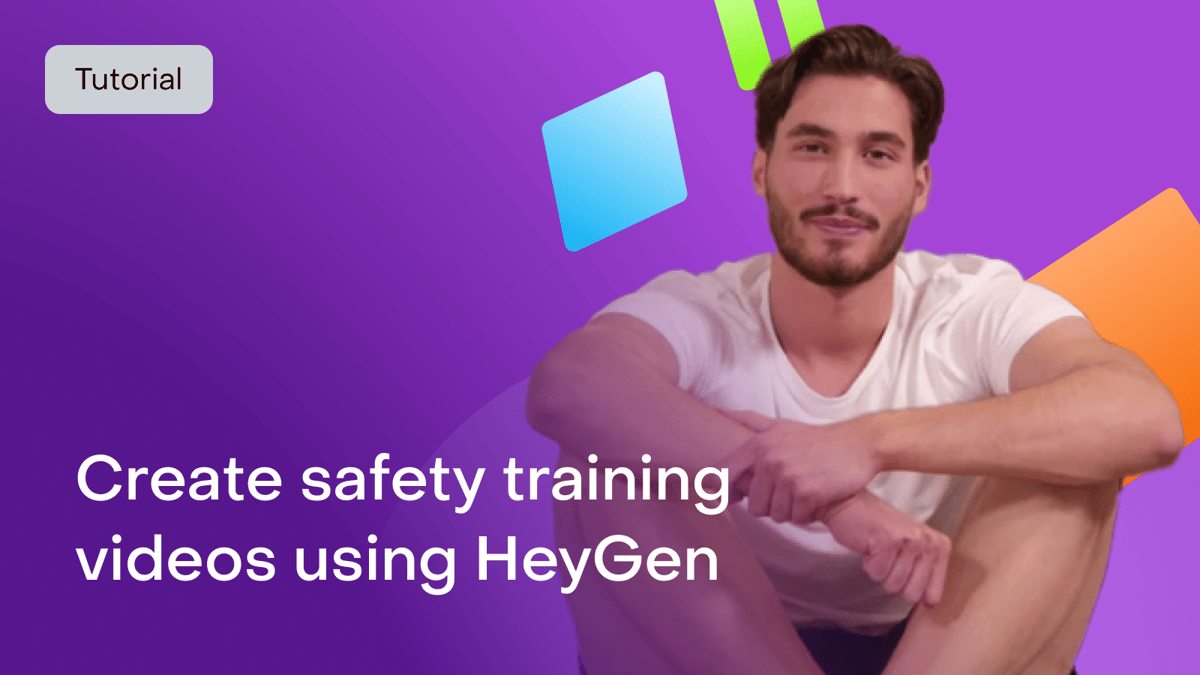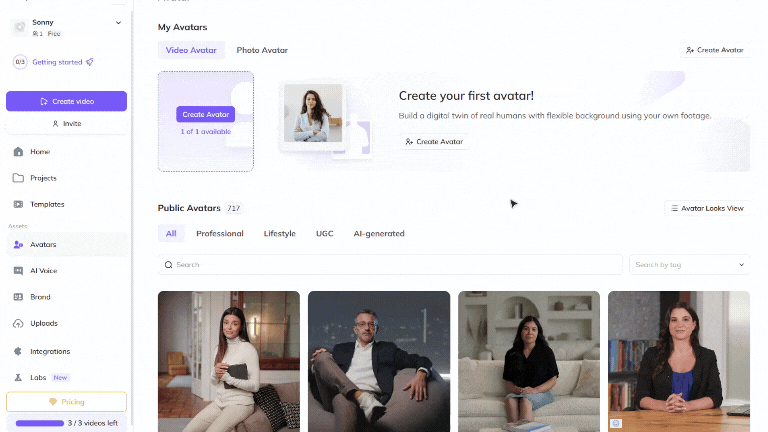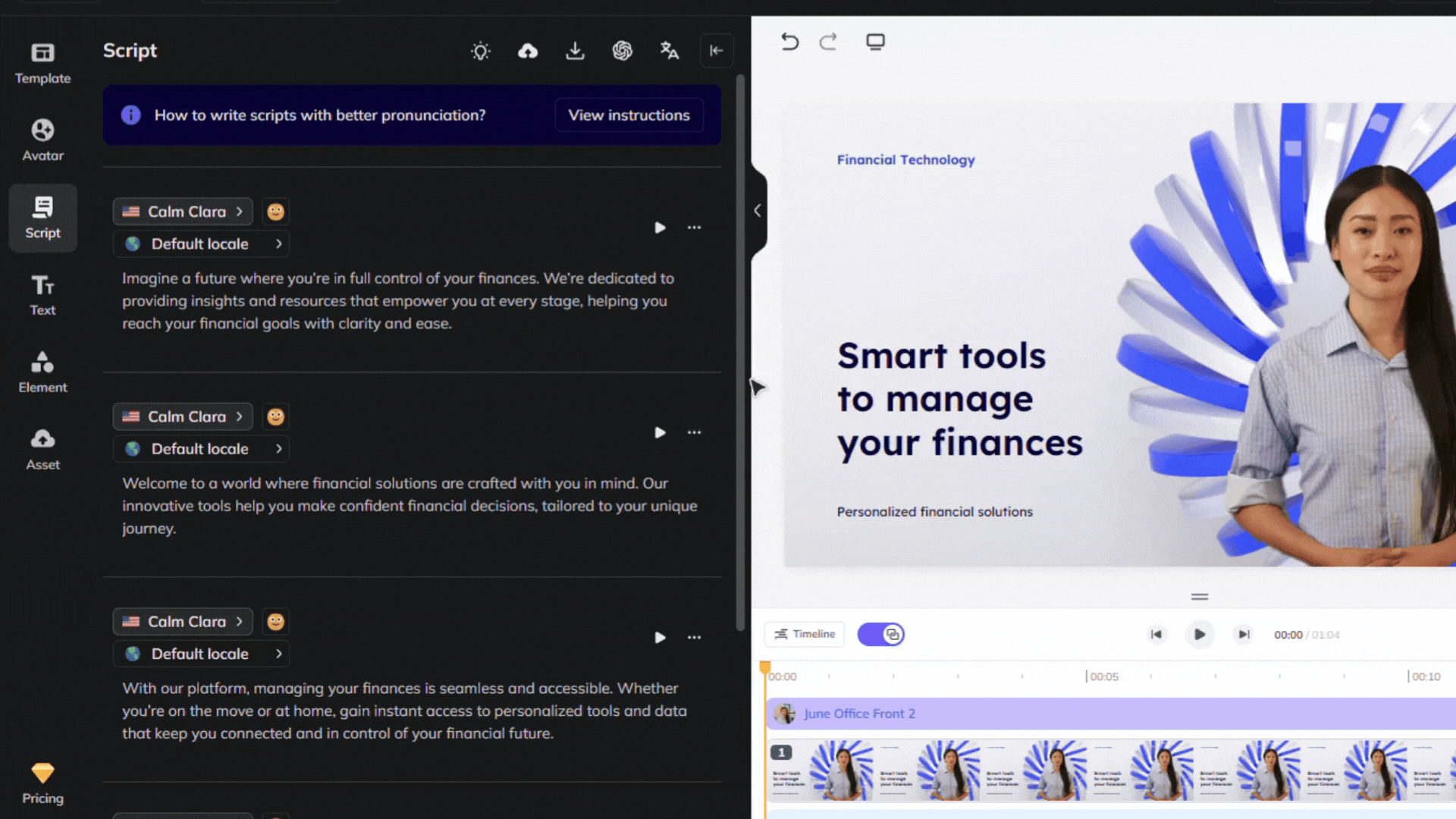Tutorial
March 14, 2024 · Last updated on April 23, 2025
How to use HeyGen for safety training

# Tutorial
-

Safety training is essential for protecting individuals at home, in the workplace, and in high-risk industries. AI-powered, lifelike avatars enable you to create engaging, scalable, and visually compelling safety training content without the need for an on-camera presenter. Whether teaching home safety, workplace procedures, or disaster preparedness, AI avatars help ensure critical safety knowledge is delivered effectively.
Why use AI avatars for safety training?
Increase engagement by using avatars with clear, authoritative narration to enhance information retention.
Standardize training across industries and workplaces, ensuring consistency in safety education.
Enhance clarity with animations, step-by-step emergency procedures, and real-world safety demonstrations.
Scale effortlessly by repurposing safety content for onboarding, refresher training, and public awareness campaigns.
Localize training for diverse audiences by translating content into multiple languages.
Step 1: Plan your safety training content
Before creating your video, determine its purpose:
- Home safety tips and emergency preparedness: Educate individuals and families on fire safety, first aid, and home security.
- Safety content for niche industries: Provide specialized safety training tailored to construction, healthcare, manufacturing, and other industries.
- Workplace safety training: Ensure employees understand protocols for hazard prevention, equipment use, and emergency response.
- Disaster response and evacuation procedures: Guide communities and organizations on how to respond effectively in emergencies.
Leverage AI tools like HeyGen’s scriptwriting assistant to craft structured and engaging safety training scripts. Not sure where to start? Here’s a sample structure for a 60-second safety training video:
Opening (0-10 seconds) – safety topic & importance
Script/Text On-Screen: “Safety isn’t optional—it’s a responsibility. Today, we’ll cover [Topic] and how you can stay prepared.”
Middle (10-40 seconds) – key safety guidelines & best practices
Visual: Demonstrations of safety procedures, hazard identification, or emergency response steps.
Script/Text On-Screen:
- “Home fire safety: Always check smoke detectors and have an evacuation plan.”
- “In construction sites, wear personal protective equipment (PPE) to prevent injuries.”
- “During a workplace emergency, follow evacuation routes and listen to safety personnel.”
Closing (40-55 seconds) – CTA & reinforcement
Visual: Call-to-action text like “Stay Safe, Stay Prepared” or “Complete Your Safety Training.”
Script/Text On-Screen:
- “Safety starts with awareness—apply these tips to protect yourself and others.”
- “Follow for more safety tips and industry best practices.”
End screen (last 5 seconds)
Visual: Organization or training provider logo, CTA button (e.g., “Learn More” or “Take the Safety Quiz”), and website or contact details.
Step 2: Choose your AI avatar
HeyGen offers a wide range of avatars to deliver safety training in a professional and authoritative manner. Whether you need an emergency responder, a workplace safety instructor, or a public safety official, HeyGen has avatars to match your training needs.

Choose a Public Avatar from HeyGen’s extensive library, featuring 700+ voices compatible with 170+ languages and dialects. Each Public Avatar also comes with multiple Looks, offering different professional and authoritative styles.
For a more personalized approach, safety trainers and corporate leaders can use HeyGen’s Custom Avatar feature to create a digital twin from their own photos and videos. For the best output, check out our Best Practices for creating AI avatars and voices. You can even tailor your avatar’s look with our Generate Looks tool to align with your safety training video's focus.
Want something unique? Explore the option to generate an avatar from text, allowing you to create avatars suited for different safety industries, workplace environments, or public awareness campaigns.
Step 3: Create different types of safety training videos
Emergency response procedures, workplace safety protocols, and industry-specific hazard prevention videos help ensure employees and individuals stay informed. These structured videos provide clear, practical safety guidance for different environments.
Home safety & emergency preparedness
Goal: Equip individuals and families with essential safety knowledge.
Best format: 60-120 seconds
Key elements:
- Fire prevention tips and evacuation plans.
- First aid demonstrations and CPR basics.
- CTA: Encourage viewers to create a home safety plan.
Industry-specific safety training
Goal: Provide specialized safety education for high-risk industries.
Best format: 90-180 seconds
Key elements:
- Industry-specific hazards and how to mitigate risks.
- Proper use of safety equipment and protocols.
- CTA: Direct workers to additional training resources.
Workplace safety training
Goal: Ensure employees understand their role in maintaining a safe workplace.
Best format: 90-180 seconds
Key elements:
- Workplace hazard identification and reporting procedures.
- Best practices for handling equipment, chemicals, and emergency situations.
- CTA: Encourage employees to complete compliance training.
Disaster response & evacuation procedures
Goal: Prepare individuals and organizations for emergency situations.
Best format: 90-180 seconds
Key elements:
- Steps to follow during natural disasters like earthquakes, floods, and fires.
- Safe evacuation routes and emergency contacts.
- CTA: Remind viewers to participate in emergency drills.
By incorporating these different types of safety training videos, you can ensure a safer environment for individuals and employees across various settings.
Step 4: Enhance your video with visuals and animations
Visual storytelling is crucial for training videos, and HeyGen makes it easy to design engaging scenes. To get started, see this step-by-step guide on how to create and edit videos in HeyGen. Polish your video to perfection with HeyGen’s intuitive editing tools. HeyGen uses a text-based editor to ensure your scenes, text and transitions align perfectly with your script.

Don’t miss our scripting tips which can help ensure accurate pronunciation and pauses for a natural flow.
Browse HeyGen’s extensive library of professionally designed templates or create your own to match your brand’s unique look and feel.
Upload assets such as product images, videos, animations, music, or screen recordings that illustrate your product’s key features.
Step 5: Distribute your video effectively
Once your video is complete, distribute it across multiple platforms:
Upload to company LMS platforms, emergency preparedness websites, or workplace training portals.
Share with employees and the public via email, Slack, or corporate intranet systems.
Encourage community engagement by prompting viewers to complete quizzes or participate in safety drills.
Alternative: Using Interactive Avatars for training
In place of or addition to a training video, consider creating an Interactive Avatar if you have or can create a knowledge base with your training material. Below are some of the benefits of using an Interactive Avatar for training:
- Scalability: save costs and scale consistent learning experiences by standardizing training across departments and locations without hiring multiple trainers
- Adaptive learning: employees can learn at their own pace, ask questions and receive instantaneous feedback
- Change management: integrate processes and policy changes instantaneously by simply updating your knowledge base
- Gamification potential: make training more dynamic by incorporating quizzes, challenges or interactive decision-making
- Easy integration: embed Interactive Avatars into LMS platforms, intranet sites and corporate learning hubs
- Data-driven insights: analyze employee progress and training effectiveness with AI-powered reporting
Interactive Avatars bring a human touch to your content by allowing viewers to ask questions and converse in real-time for the most engaging adaptive learning. They can allow organizations to scale consistent learning experiences, Demo Interactive Avatars here and follow the steps in this Interactive Avatar guide to learn how to set up your own!
Bonus tips
- Keep it practical: Use real-world scenarios to illustrate safety protocols.
- Make it interactive: Encourage viewers to test their knowledge through quizzes.
- Ensure accessibility: Offer subtitles and multilingual training for diverse audiences.
- Update regularly: Safety guidelines evolve—keep content current and relevant.
By integrating lifelike avatars into your safety training strategy, you can engage learners, scale content effortlessly, and promote safer environments. AI-powered avatars make safety education more accessible, consistent, and visually compelling. Start creating AI-driven safety training videos today and help your audience stay prepared and protected!
Like
Comments (0)
Popular
Table Of Contents

